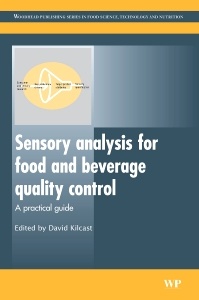Description
Sensory Analysis for Food and Beverage Quality Control
A Practical Guide
Woodhead Publishing Series in Food Science, Technology and Nutrition Series
Language: English
Subject for Sensory Analysis for Food and Beverage Quality Control:
Support: Print on demand
Description
/li>Contents
/li>Biography
/li>Comment
/li>
Producing products of reliable quality is vitally important to the food and beverage industry. In particular, companies often fail to ensure that the sensory quality of their products remains consistent, leading to the sale of goods which fail to meet the desired specifications or are rejected by the consumer. This book is a practical guide for all those tasked with using sensory analysis for quality control (QC) of food and beverages.
Chapters in part one cover the key aspects to consider when designing a sensory QC program. The second part of the book focuses on methods for sensory QC and statistical data analysis. Establishing product sensory specifications and combining instrumental and sensory methods are also covered. The final part of the book reviews the use of sensory QC programs in the food and beverage industry. Chapters on sensory QC for taint prevention and the application of sensory techniques for shelf-life assessment are followed by contributions reviewing sensory QC programs for different products, including ready meals, wine and fish. A chapter on sensory QC of products such as textiles, cosmetics and cars completes the volume.
Sensory analysis for food and beverage quality control is an essential reference for anyone setting up or operating a sensory QC program, or researching sensory QC.
Part 1 Designing a sensory quality control program 1. Designing a sensory quality control program 2. Selection and management of staff for sensory quality control 3. Proficiency testing of sensory panels
Part 2 Methods for sensory quality control and analysis of results 4. Sensory methods for quality control 5. Establishing product sensory specifications 6. Combining instrumental and sensory methods in food quality control 7. Statistical approaches to sensory quality control
Part 3 Sensory quality control in practice 8. Using sensory techniques for shelf-life assessment 9. Sensory quality control for taint prevention 10. Sensory quality definition of food ingredients 11. Sensory quality control in the chilled and frozen ready meal, soup and sauce sectors 12. Sensory quality control in the wine industry 13. Sensory quality control of distilled beverages 14. Sensory quality control of fresh produce 15. Sensory quality management of fish 16. Sensory quality control in food service 17. Sensory quality control of consumer goods other than food
- Highlights key aspects to consider when designing a quality control program including sensory targets and proficiency testing
- Examines methods for sensory quality control and statistical data analysis
- Reviews the use of sensory quality control programs in the food and beverage industry featuring ready meals, wine and fish




